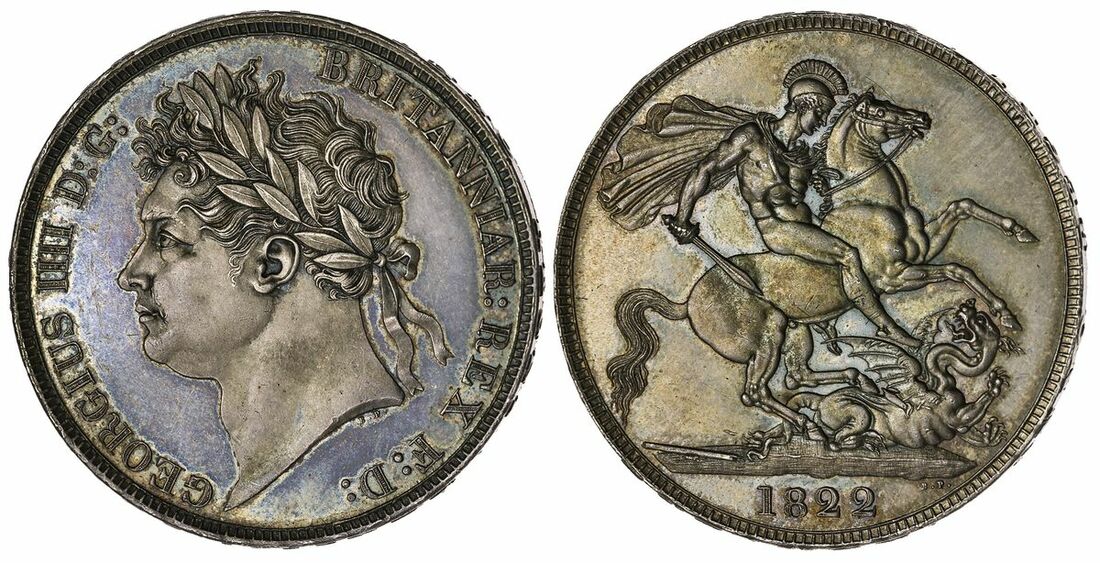
Auction: 23006 - The Official COINEX Auction at Spink
Lot: 306
George IV (1820-1830), Crown, 1822 TERTIO, by Benedetto Pistrucci, GEORGIUS IIII D: G: BRITANNIAR: REX F: D:, laureate head left, rev. St George and Dragon, WWP under broken lance, lettered edge downwards, 28.26g, 6h (ESC 252; Bull 2320; Spink 3805), small scuff on jowls, nevertheless with a handsome lustrous flaring and purple-blue and olive green cabinet tone, with much eye appeal, good extremely fine and virtually as struck
Provenance
Bearnes Hampton & Littlewood, Sporting and Collectors' Sale, 21 March 2023, lot 759
There are only two 'business' strikings of a George IV Crowns, one minted in the year of his Coronation (1821), and the other, as here, in 1822. The release of such coins followed on from the attempted revitalisation of the use of Crowns late during the reign of George III, after their popularity had declined from the 17th century onwards.
In 1816, Italian cameo sculptor Benedetto Pistrucci came to London and was asked by William Wellesley Pole, Master of the Royal Mint, to create designs for the new coinage. Pistrucci had been inspired by a wax model by Nathaniel Merchant shown to him by Lady Lavinia Spencer that depicted St. George and the Dragon. Pistrucci decided to portray the English patron saint (allegedly modelled by an Italian waiter, Pistrucci had met whilst staying in Leicester Square) atop an ardent horse, moments after the beast had been fatally wounded. In the initial design, used for George III Sovereigns (from 1817), St George bears a broken spear, whilst the rest of the shaft lies both on the floor and embedded in the clawing Dragon's chest. However, in 1818, this iconography was modified for the Crown - the spear changing to a sword - which is what we also see on this 1822 issue. When George IV ascended the throne, after ten years acting as Prince Regent, Pistrucci began working on the coinage bust for the new King. He also decided to keep the sword design on the reverse but make other slight changes, including the removal of the helmet streamer and the exclusion of the motto banner. It was this version that adorned both sovereigns and crowns throughout the last Hanoverian king's reign, and although proofs were struck in 1825 and 1826 for crowns that had a shield depicted instead of the mythic iconography, they never entered circulation. Pistrucci engraved the dies himself, after the Royal Mint failed to successfully reproduce the imagery, all for a fee of one hundred guineas.
Nowadays, the George and the Dragon design is widely regarded as iconic, having been described as one of the 'handsomest coins in Europe' and a 'noble innovation,' however, opinions of Pistrucci's work have not always been so aligned in appreciation. Contemporary public opinion did not take kindly to the inclusion of his full name of both sides of the George III crown, something he must have noted, as it was only his initials 'B. P.' that appear on the George IV issues. The dramatic positioning of the saint on horseback was also criticised, as many felt it looked as though he looked unstable, dangerously close to falling off with the next blow. One such disgruntled entry in the British Museum Quarterly 1932, heavily opposed the so-called 'degenerate' change from lance to sword, claiming that it made an unrealistic mockery of the scene, and destroyed the animated force of the composition: "the saint has armed himself afresh [and] apparently intends to inflict a coup de grâce [but] the weapon is not one with which he could reach the dragon while retaining his seat in the saddle". In some ways, this is a considered point, as the inclusion of both the lance on the floor and the sword in hand implies that the blow was not enough to kill the monster and that more attack was still needed.
King George IV himself was not pleased with the coin, detesting his bloated effigy which could be said to "impl[y] something of the appetites of the monarch" (Clancy 2017, 2015, p. 67), and he would also come into conflict with Pistrucci over his coronation medal, demanding he be elevated above the allegorical representations of kingdoms. His unhappiness was to cause series problems for the Italian. Pole resigned from the Mint in 1823, divesting Pistrucci a supporter, and when he refused to copy the work of sculptor Francis Chantrey, who had prepared a favoured bust of the King, he was excluded from further work on the coinage.
This 1822 Crown is a key marker in the story of numismatic design. It acts as a reminder of past innovation, an education in aesthetic iconographic choices, and an instruction of political tensions between the King and his Mint. The George and the Dragon motif would not resurface until 1874 under the reign of Queen Victoria, however Pistrucci would not live to see his iconic work come back into favour, never being able to rectify the disfavour he found himself in, as an outsider.
Subject to 20% VAT on Buyer’s Premium. For more information please view Terms and Conditions for Buyers.
Sold for
£2,200
Starting price
£1300




